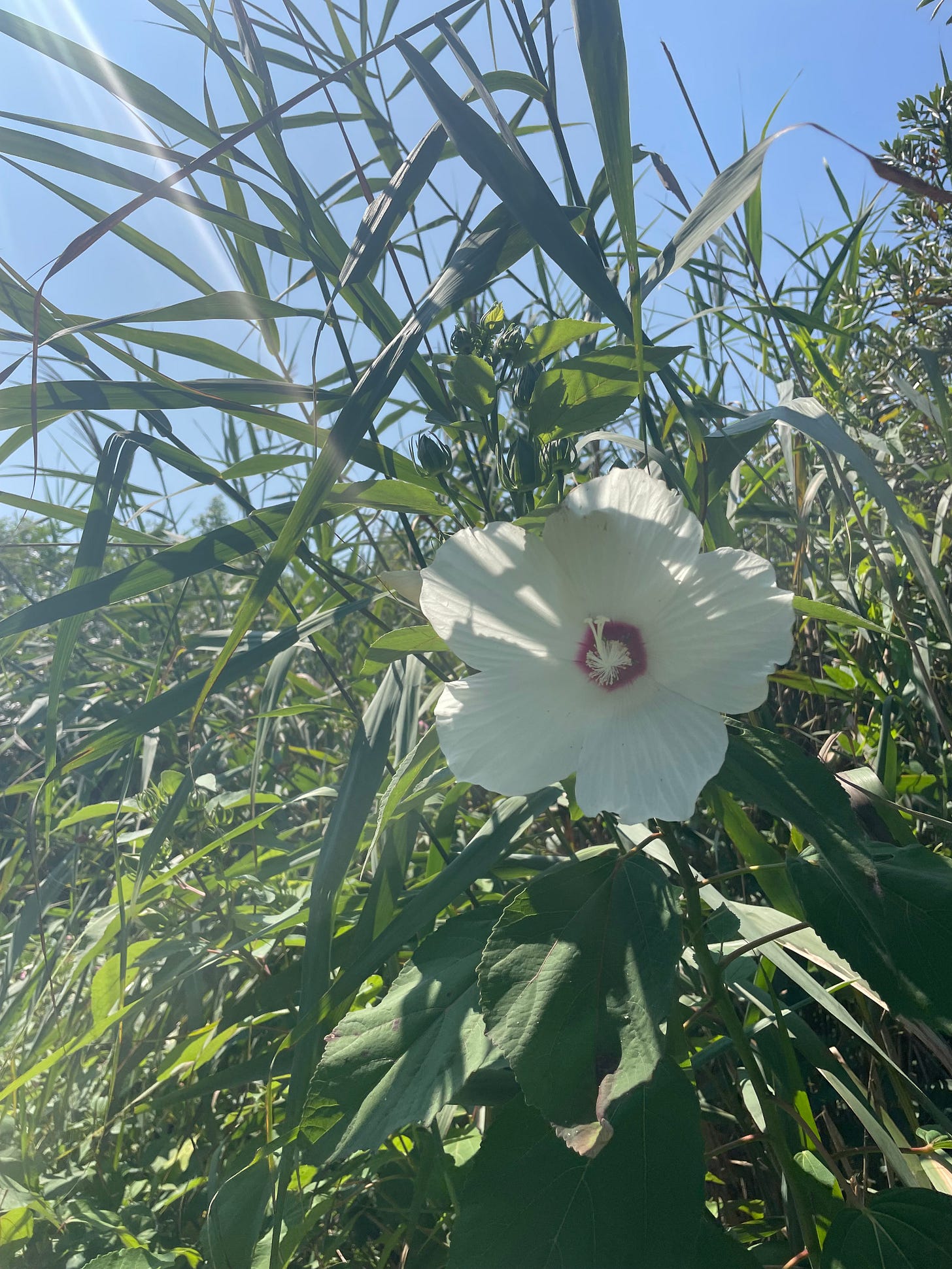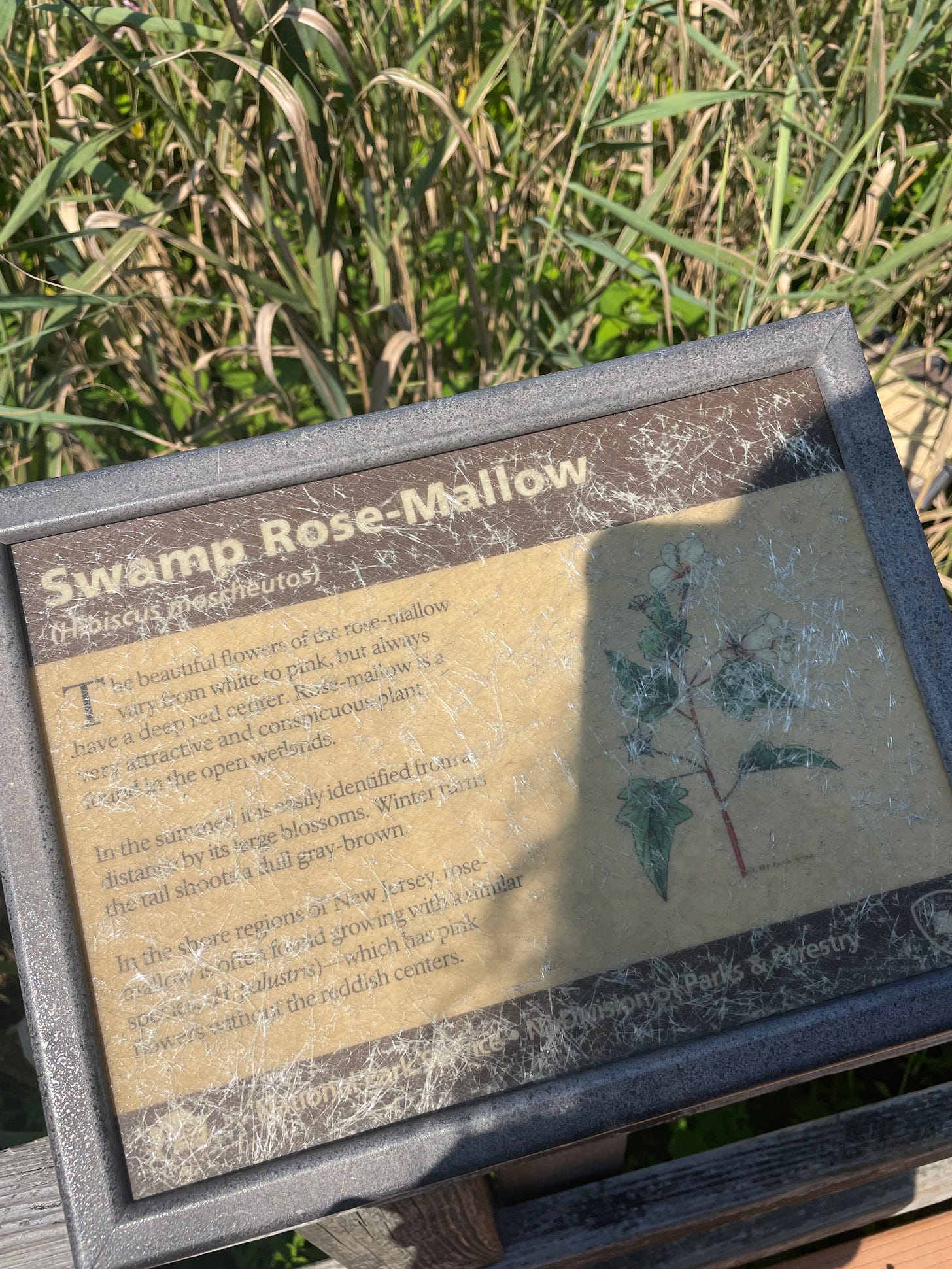The Surprising History of Marshmallows
A medicinal, ancestral treat found in a swamp near you
On Monday my parents and I decided to walk along a nature path by the beach. We saw many different plants and animals including turtles, monarchs, cardinals, and beautiful tropical-looking flowers.
While the tropical-looking flowers looked almost identical to hibiscus, it turned out they were something called Swamp Rose-Mallow. Funny enough, both are actually members of the Malvaceae family, along with okra, cacao, and cotton.
If the name of the Rose-Mallow plant sounds familiar, it’s probably because it sounds a lot like the word marshmallow. In fact, the root of this plant was traditionally used to make marshmallows, hence the name!
Marshmallow root was a common herb used in medicinal teas and tinctures, beginning with the Egyptians and carrying throughout many European cultures for the last 2,000 years.
Today’s newsletter explores the history of marshmallows and how we went from a medicinal plant to a squishy corn syrup-laden dessert. Selfishly, I’m writing this newsletter to teach myself more about the plant I saw in the swamp the other day but also to hopefully rub some of my curiosity off on you.
Identifying plants was an essential skill our ancestors needed to survive. They needed to know which plants were poisonous and which were medicinal, a skill rare in the modern-day, but still so important.
While we no longer depend on our innate plant wisdom to survive, it can help us unlock a host of beneficiary ingredients just in our backyard. And what is more ancestral than using local, medicinal herbs to support your and your family’s health?
The history of the marshmallow
2,000 years ago marks the first recorded use of the mallow plant. The Egyptians were said to boil the root of the plant in honey, allowing the medicinal sap to release and the mixture to thicken. Then they would form this mixture into cakes to feed to only the most prestigious in the kingdom- the pharaohs and gods.
These mallow cakes were so prized that it was considered a crime for anyone else to eat them.
Later during the rise of ancient Rome, this same recipe was used as food to nourish the people. This is also when those in ancient Greece discovered that the mallow plant was quite medicinal and could be used to treat wounds.
In the European Renaissance, mallow became even more popular for its medicinal properties than ever before. It was used to treat everything from the common cold to digestive issues.
More recently, in the late 19th century in France, the mallow became what we commonly know it as today- the marshmallow. The French realized that its sap could be mixed with honey and egg whites to create a sweet, fluffy candy.
As this treat grew in popularity, they needed to figure out a way to speed up the production process. Because the root of the mallow took so long to boil in order to extract the sap, it was quickly replaced by gelatin.
Gelatin, or peptides and protein derived from animal skin and bones, gave the marshmallow the same whipped, gooey texture as the mallow sap without all the intense labor. Eventually, as the treat made its way to America, the honey was replaced with cheap, processed ingredients like corn syrup, and the gelatin was replaced with stabilizers like xanthan gum.
A once medicinal treat quickly became quite the opposite- a candy contributing to diabetes, illness, and disease.
Marshmallows as medicine
It is the sap from the root of the mallow plant that holds all of the medicinal power. This sap contains flavonoids called kaempferol and quercetin, both known to be extremely anti-inflammatory.
It is also made of a soluble fiber called mucilage which is the same type of fiber found in chia seeds and okra. If you’ve ever tasted okra, then you know it has a slimy fibrous texture- this is the mucilage!
While all parts of the plant are edible, the roots of the plant are commonly dried to produce the marshmallow herb we now use in teas and tinctures. Because it’s also a great anti-microbial, the tea is perfect for soothing sore throats and coughs.
Because it also contains inulin and is wet and cooling (hence the environment where it grows!), it makes a lovely natural remedy for digestive issues and ulcers.
Unfortunately, marshmallow isn’t as common of an herbal remedy as it once was. Hopefully, with proper education, we can reawake this innate knowledge of all the natural medicine growing on this Earth. I am confident it is within each of us! We just need to tap it awake.
Medicinal marshmallow recipe
While most marshmallows today are full of sugar and corn syrup, there is a way to make marshmallows delicious and medicinal!
This recipe from Grow Forage Cook Ferment uses grass-fed gelatin, raw honey, and marshmallow root powder. I’ve also seen people making marshmallows without the marshmallow root powder, but I recommend adding it in to experience the medicinal properties!
Ingredients:
1 cup water
3 tbsp grass-fed gelatin
1 cup raw honey (buy yours locally!)
1/2 tsp salt
1/2 tsp vanilla bean powder
1 tbsp marshmallow root powder
1/2 cup arrowroot powder
You’ll also need a stand mixer, small pot, candy thermometer, parchment paper, spatula, and a baking pan. For instructions, check out the recipe here.
Other ways to use mallow
Interestingly enough, because of the mucousy properties of mallow, you can use marshmallow root powder as a thickener in recipes like soups and stews. This makes a great alternative to cornstarch, gums, and flour!
If using the powder, you can also combine this with coffee and tea. Some people say you can add it to coffee in a coffee grinder and steep it with your morning brew. Keep in mind that it will thicken up if left to sit. If it does, make sure to drink this as this is where a lot of the beneficial compounds live!
While I have yet to try the marshmallow recipe myself, I can definitely say I will be purchasing some gelatin and marshmallow root powder to try it. I’m picturing myself cozied up outside around the campfire, a warm cup of cacao with a truly medicinal marshmallow plopped in my mug.
And, of course, there are close friends sitting around the fire with me, also enjoying their homemade medicine.
Take action: See what herbs grow naturally where you live. See if you can spot them on a nature walk! Be fully present on your walk and when you get home, research what that herb has traditionally been used for.
I truly believe every plant and herb on this Earth serves some greater purpose. Our ancestors knew this and now it is up to us to re-discover it.
I would love to hear what herb you found that grows where you live. Even if you don’t spot it on your walk, leave a comment and share! I want to hear what medicine you have growing in your backyard.
Have a lovely day!
Madison



